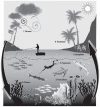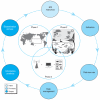Critical issues in the development of health information systems in supporting environmental health: a case study of ciguatera
- PMID: 21163721
- PMCID: PMC3094406
- DOI: 10.1289/ehp.1002575
Critical issues in the development of health information systems in supporting environmental health: a case study of ciguatera
Abstract
Background: Emerging environmental pressures resulting from climate change and globalization challenge the capacity of health information systems (HIS) in the Pacific to inform future policy and public health interventions. Ciguatera, a globally common marine food-borne illness, is used here to illustrate specific HIS challenges in the Pacific and how these might be overcome proactively to meet the changing surveillance needs resulting from environmental change.
Objectives: We review and highlight inefficiencies in the reactive nature of existing HIS in the Pacific to collect, collate, and communicate ciguatera fish poisoning data currently used to inform public health intervention. Further, we review the capacity of existing HIS to respond to new data needs associated with shifts in ciguatera disease burden likely to result from coral reef habitat disruption.
Discussion: Improved knowledge on the ecological drivers of ciguatera prevalence at local and regional levels is needed, combined with enhanced surveillance techniques and data management systems, to capture environmental drivers as well as health outcomes data.
Conclusions: The capacity of public HIS to detect and prevent future outbreaks is largely dependent on the future development of governance strategies that promote proactive surveillance and health action. Accordingly, we present an innovative framework from which to stimulate scientific debate on how this might be achieved by using existing larger scale data sets and multidisciplinary collaborations.
Figures



Similar articles
-
Ciguatera fish poisoning and environmental change: a case for strengthening health surveillance in the Pacific?Pac Health Dialog. 2010 Sep;16(2):99-108. Pac Health Dialog. 2010. PMID: 21714346
-
Ciguatera and scombroid fish poisoning in the United States.Foodborne Pathog Dis. 2013 Dec;10(12):1059-66. doi: 10.1089/fpd.2013.1514. Epub 2013 Oct 5. Foodborne Pathog Dis. 2013. PMID: 24093307
-
Outbreak bias in illness reporting and case confirmation in ciguatera fish poisoning surveillance in south Florida.Public Health Rep. 2006 Nov-Dec;121(6):658-65. doi: 10.1177/003335490612100605. Public Health Rep. 2006. PMID: 17278400 Free PMC article.
-
Ciguatera: recent advances but the risk remains.Int J Food Microbiol. 2000 Nov 1;61(2-3):91-125. doi: 10.1016/s0168-1605(00)00382-2. Int J Food Microbiol. 2000. PMID: 11078162 Review.
-
Ciguatera in Mexico (1984⁻2013).Mar Drugs. 2018 Dec 28;17(1):13. doi: 10.3390/md17010013. Mar Drugs. 2018. PMID: 30597874 Free PMC article. Review.
Cited by
-
Digital Technologies and Open Data Sources in Marine Biotoxins' Risk Analysis: The Case of Ciguatera Fish Poisoning.Toxins (Basel). 2021 Sep 30;13(10):692. doi: 10.3390/toxins13100692. Toxins (Basel). 2021. PMID: 34678985 Free PMC article.
-
In vivo subchronic effects of ciguatoxin-related compounds, reevaluation of their toxicity.Arch Toxicol. 2022 Sep;96(9):2621-2638. doi: 10.1007/s00204-022-03315-0. Epub 2022 Jun 3. Arch Toxicol. 2022. PMID: 35657391 Free PMC article.
-
Sugar Production Leads to Occupational, Community and Planetary Health Problems.Ecohealth. 2025 Mar;22(1):1-4. doi: 10.1007/s10393-025-01699-w. Epub 2025 Feb 13. Ecohealth. 2025. PMID: 39945999 No abstract available.
-
Ciguatera Mini Review: 21st Century Environmental Challenges and the Interdisciplinary Research Efforts Rising to Meet Them.Int J Environ Res Public Health. 2021 Mar 15;18(6):3027. doi: 10.3390/ijerph18063027. Int J Environ Res Public Health. 2021. PMID: 33804281 Free PMC article. Review.
-
Digital health for climate change mitigation and response: a scoping review.J Am Med Inform Assoc. 2022 Nov 14;29(12):2140-2152. doi: 10.1093/jamia/ocac134. J Am Med Inform Assoc. 2022. PMID: 35960171 Free PMC article.
References
-
- Adachi R, Fukuyo Y. The thecal structure of marine toxic dinoflagellate Gambierdicus tocicus gen. et sp. nov. collected in ciguatera endemic area. Bull Jap Soc Sci Fish. 1979;45:67–71.
-
- Anderson BS, Sims JK, Wiebenga NH, Sugi M. The epidemiology of ciguatera fish poisoning in Hawaii, 1975–1981. Hawaii Med J. 1983;42(10):326–334. - PubMed
-
- Angibaud G, Lévêque JM, Laurent D, Gaultier C. Neurological features after consumption of a variety of neo-Caledonian shellfish. Rev Neurol (Paris) 2000;156(1):65–66. - PubMed
-
- Bagnis R. The ciguatera type ichtyosarcotoxism—a complicated phenomena of marine and human-biology. Oceanologica Acta. 1981;4(3):375–387.
-
- Bagnis R, Chanteau S, Chungue E, Hurtel JM, Yasumoto T, Inoue A. Origins of ciguatera fish poisoning: a new dianoflagellate, Gambierdiscus toxicus Adachi and Fukuyo, definitely involved as a causal agent. Toxicon. 1980;8(2):199–208. - PubMed
MeSH terms
LinkOut - more resources
Full Text Sources
Medical

